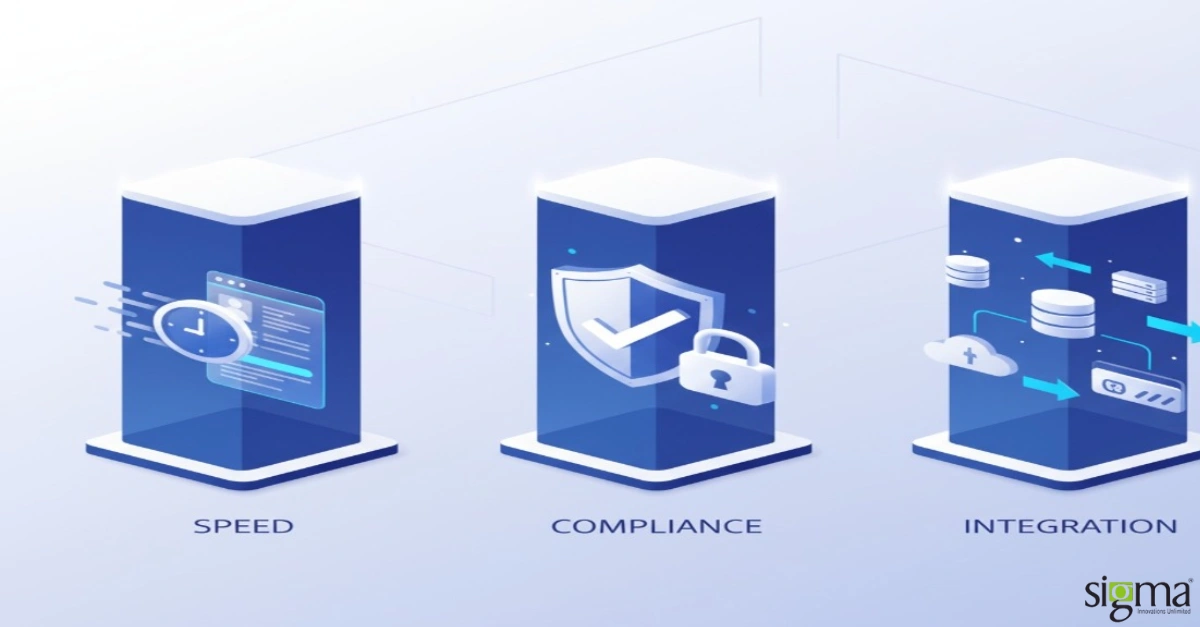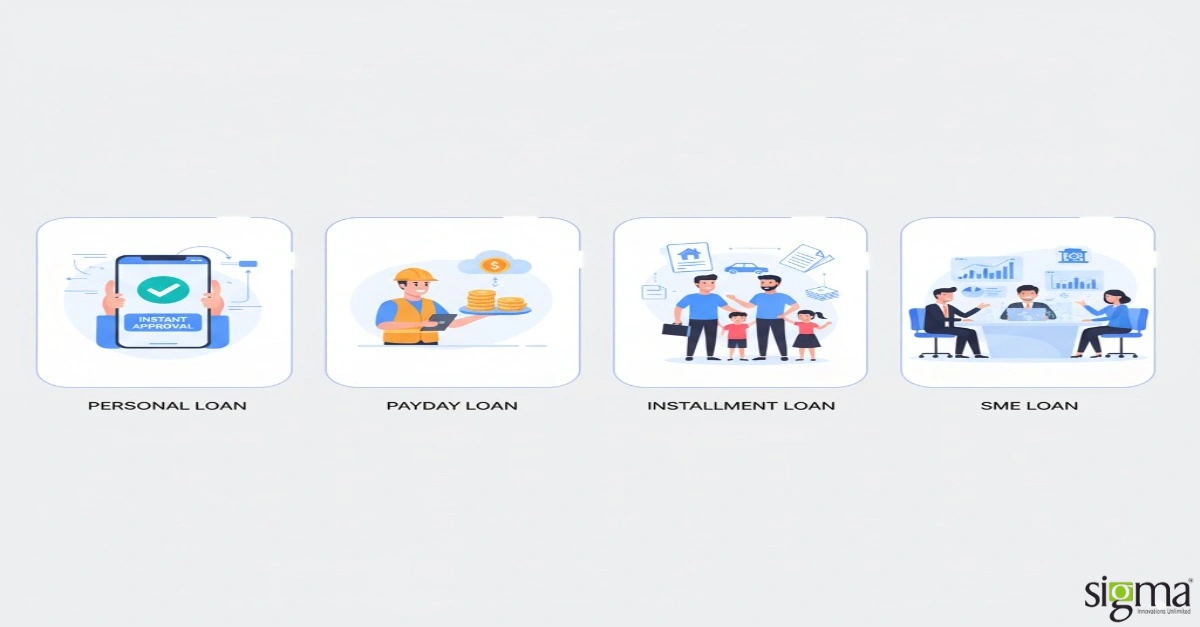Online Loan Application Software: Choosing the Right Software for Your Business

Key Highlights:
- Faster, smoother lending experiences – Online loan application software automates origination, underwriting, and collections, cutting down on delays, reducing manual errors, and building borrower trust.
- Designed for every loan, built for compliance – From personal loans to mortgages and SME financing, the software adapts to different workflows while ensuring security, regulatory compliance, and fraud protection.
- Connected systems, smarter decisions – Integrations with credit bureaus, payment gateways, and analytics tools enable real-time processing, transparent borrower updates, and data-driven insights.
What’s the real cost of digital transformation delays in your lending operations? How many opportunities are you forfeiting due to sluggish application processing or escalating compliance risks? With two decades of strategic client partnerships, spanning from dynamic Silicon Valley startups to established European enterprises, we’ve observed a consistent truth: the right digital lending solution isn’t just about efficiency; it’s about competitive advantage and sustained profitability. Our FinTech solutions have serviced billions worth of loans and contributed to the origination of over several loans, demonstrating a profound impact on lending operations globally.
Our two decades of deep industry engagement show that a strategic shift to digital loan application capabilities automates and centralizes your entire lending process, fundamentally enhancing speed, accuracy, and the borrower experience far beyond traditional methods. This isn’t merely about adopting new technology; it’s about a strategic investment that drives tangible business outcomes.
What Is Online Loan Application Software and Why It Matters
The difference between traditional and digital lending isn’t just speed, it’s fundamentally about borrower expectations and competitive positioning. Borrowers who can get approved for credit cards instantly won’t tolerate loan processes that take weeks, especially when your competitors offer decisions in hours.
Online loan application software creates a completely digital ecosystem that operates continuously, processes applications through automated workflows, and provides transparency that builds genuine borrower trust. But here’s what most lenders misunderstand: this isn’t just about moving paper forms online, it’s about reimagining how you evaluate creditworthiness and manage relationships.
Key capabilities include:
- Intelligent data collection that pulls information automatically rather than requiring manual entry
- Dynamic risk assessment using real-time data sources beyond traditional credit reports
- Transparent communication with proactive status updates and clear requirement explanations
- Streamlined operations through exception-based processing and automated compliance monitoring
These solutions accelerate loan origination by automating document verification and integrating underwriting engines, enabling lenders to process higher volumes while maintaining strict risk standards. The system handles routine decisions automatically while escalating complex scenarios to experienced underwriters.
The business impact extends beyond operational efficiency. Lenders using sophisticated loan application software report improved borrower satisfaction scores, reduced compliance incidents, and significant cost savings through automated workflows that eliminate manual redundancies.

Types of Digital Loan Applications Supported
Different loan types demand fundamentally different technological approaches, and trying to force all lending into a single workflow creates inefficiencies that undermine both borrower experience and operational efficiency. Here’s how leading lenders are handling various loan categories:
Personal Loans: Speed and simplicity drive personal loan success. Borrowers expect instant gratification with application-to-funding timelines measured in hours, not days. The software needs real-time credit bureau integration, automated income verification through bank account analysis, and dynamic pricing engines that adjust rates based on risk assessment.
Payday Loans: These high-frequency, short-term loans require rapid decisioning capabilities combined with complex state-by-state compliance monitoring. Integration with state databases for borrower eligibility verification and automated fee calculation becomes crucial for avoiding regulatory violations.
Installment Loans: Whether financing auto purchases, home improvements, or education expenses, installment lending requires sophisticated amortization engines and flexible payment scheduling. The challenge lies in long-term servicing integration, your origination system must connect seamlessly with loan servicing solutions.
Commercial and SME Loans: Business lending demands enterprise-grade capabilities including financial statement analysis, cash flow modeling, and collaborative underwriting workflows. Integration with accounting software, tax return analysis tools, and business intelligence solutions becomes essential.
| Loan Type | Processing Speed Target | Key Integration Requirements | Compliance Focus |
|---|---|---|---|
| Personal Loans | 5-15 minutes | Credit bureaus, income verification | Fair lending, data privacy |
| Payday Loans | 1-5 minutes | State databases, payment processing | State regulations, cooling-off periods |
| Installment Loans | 15-45 minutes | Servicing systems, payment networks | Truth in Lending, collections compliance |
| Commercial Loans | 2-7 business days | Accounting software, business databases | Commercial lending regulations |

Key Features to Look for in Loan Application Software
Feature evaluation should focus on business impact rather than technical sophistication. The most impressive capabilities don’t matter if they don’t address your specific operational challenges or borrower needs.
Customizable Dashboards: Your lending team needs information that accelerates decision-making, not just comprehensive data displays. Effective dashboards surface exception-based information first, applications requiring manual review, compliance flags, and pipeline bottlenecks that affect throughput.
Cloud-Based Access: True cloud-native solutions offer automatic scaling, built-in disaster recovery, and API-first architecture for seamless integrations. However, not all “cloud” solutions are equivalent; some vendors simply moved on-premise software to hosted servers without redesigning for cloud advantages.
Automation and Workflow Management: Smart automation eliminates bottlenecks rather than just digitizing existing inefficiencies. The system should identify where applications get stuck and automatically route them to available underwriters or flag them for priority review.
AI-Powered Fraud Detection: Modern fraud detection uses behavioral analytics and consortium data to identify suspicious patterns that traditional rule engines miss. However, AI systems require careful tuning to avoid false positives that create borrower friction.
Compliance Management: Built-in compliance should prevent violations rather than just detecting them after occurrence. The software should block non-compliant actions and guide users toward appropriate alternatives.
Sigma’s digital lending solutions combine cloud infrastructure with AI automation while maintaining human touchpoints for complex scenarios, recognizing that lending remains a relationship business even when technology handles most operational tasks.
Automation and Workflow Management
Most lending automation initiatives fail because they automate broken processes instead of fixing them first. We’ve seen lenders invest heavily in sophisticated software only to replicate the same inefficiencies that plagued their manual workflows.
Effective automation requires understanding your current bottlenecks. Which manual tasks consume the most time? What causes compliance violations? Where do applications typically get stuck? Only after mapping these pain points can you design automation that creates genuine value.
Intelligent workflow management adapts based on real-time conditions, if your senior underwriter is unavailable, applications automatically redistribute rather than creating backlogs. Machine learning optimizes task assignments based on individual expertise and workload, reducing average processing time by 35-50%.
Automated underwriting handles straightforward approvals and denials while escalating complex scenarios to human experts. We typically see the best results when 60-70% of applications process automatically, with the remainder requiring manual review for relationship or risk management reasons.

Integration Capabilities with Financial Systems
Integration complexity consistently exceeds vendor estimates, often doubling implementation timeframes. The challenge isn’t technical capability, it’s connecting modern software to legacy financial infrastructure that wasn’t designed for real-time data exchange.
Critical integration points include:
- Real-Time Credit Checks: Automated bureau access speeds risk assessment while providing fallback mechanisms for system outages
- Payment Processing: Direct connections to ACH networks, wire transfer systems, and international payment rails for global lending operations
- Core Banking Sync: Bidirectional data flow maintaining consistency between loan origination and customer account systems
- CRM Connectivity: Unified borrower relationship management providing complete interaction history for relationship-based lending decisions
Security and Compliance Features
Security breaches in lending average $5.9 million in direct costs, plus regulatory penalties that can reach tens of millions. Your software’s security architecture isn’t just about protection, it’s about business continuity and competitive positioning.
Leading solutions implement advanced security including data encryption, multi-factor authentication, and continuous monitoring, to protect sensitive borrower information while meeting evolving regulatory requirements.
Essential security features include:
- SOC 2 Type II Certification: Audited organizational controls for risk management
- AML and KYC Automation: Real-time verification through integrated databases and biometric analysis
- Secure API Management: Authentication and encryption protecting data exchanges with credit bureaus and payment systems
- Comprehensive Audit Trails: Real-time monitoring and detailed logs for regulatory examination preparation
Looking for AI-Driven RegTech Compliance Automation Solutions for Digital Lending? Collaborate with Sigma Infosolutions now.
Understanding the Loan Application Process with Software
Modern lending operations have eliminated traditional “application review meetings” where loan officers manually discuss each file. Instead, intelligent workflows handle routine decisions while humans focus on relationship building and complex credit scenarios.
Digital application submission uses progressive disclosure to collect information gradually, reducing borrower overwhelm. Smart systems start with basic information and dynamically request additional details based on loan type and initial risk assessment, improving completion rates by 40-60%.
Automated verification happens in real-time through integrated systems—employment verification through payroll connections, income verification through bank account analysis, and credit verification through bureau APIs. These processes typically complete in 2-3 minutes compared to 2-3 days for manual verification.
Centralized review presents applications in priority order based on loan amount, risk profile, and time sensitivity. Exception-based processing ensures straightforward applications move through automated approval while complex scenarios receive appropriate human attention.
How to Choose the Right Loan Application Software for Your Business
Software selection requires balancing current needs with future growth trajectory. The wrong choice can set your lending operation back 18-24 months while you implement and optimize a replacement system.
Key evaluation factors:
- Scalability: Can the software handle growth from 500 to 5,000 monthly applications without expensive upgrades?
- Integration Capabilities: Does it connect with your core banking system, credit bureaus, and payment networks without requiring expensive middleware?
- Compliance Features: Are regulatory requirements for your specific loan types and geographic markets fully supported?
- User Experience: Will both borrowers and staff find the interface intuitive enough to minimize errors and training requirements?
- Vendor Support: Does the provider offer realistic implementation timelines, comprehensive training, and reliable ongoing assistance?
Fintech software development services with Cloud-based solutions typically provide faster deployment and reduced infrastructure overhead, but they create dependencies on vendor stability and service quality that affect your operational continuity.
Assessing Usability and Customer Experience
Borrower experience directly impacts profitability, every additional minute in the application process increases abandonment rates by 3-7%. For lenders processing $50M annually, that translates to potentially $3.5M in lost originations.
Mobile responsiveness means understanding how people actually interact with financial applications on smartphones: shorter attention spans, simplified navigation preferences, and error-resistant interfaces with immediate feedback mechanisms.
Clear communication eliminates industry jargon that creates borrower confusion. Instead of “insufficient documentation,” effective systems explain “We need a recent pay stub to confirm your income, you can upload it using your phone’s camera.”
Self-service portals should enable document submission, application status tracking, and direct communication with underwriters without requiring phone calls, while providing intelligent escalation paths when borrowers need human assistance.
Evaluating Pricing Models and ROI
Focus on total cost of ownership rather than licensing fees. Successful implementations typically require 1.5-2x the initial software cost in integration, training, and process redesign expenses.
Risk-based pricing technology enables competitive advantage through real-time rate optimization based on market conditions, portfolio performance, and borrower risk profiles. This capability can improve loan margins by 0.25-0.75% while maintaining market competitiveness.
Typical operational improvements (according to studies on AI-driven processing):
- 50-70% reduction in application processing time
- 85-95% decrease in manual data entry requirements
- 40-60% improvement in completion rates
- 25-35% reduction in compliance labor costs
Platforms like Fuse provide data-driven pricing insights that improve margins while accelerating approvals, demonstrating how analytics create sustainable competitive advantages.
Common Challenges in Digital Loan Applications and How Software Solves Them
Application abandonment affects online loan applications, but smart solutions address this through progressive engagement, automatic progress saving, and contextual help that guides borrowers through complex requirements.
Manual workflow bottlenecks create inconsistent decisions and compliance risks. Automation applies consistent credit criteria while maintaining flexibility for exception scenarios requiring human judgment.
Integration failures create subtle data inconsistencies and operational workarounds that gradually undermine efficiency. Modern solutions include automated retry logic, real-time monitoring, and fallback mechanisms for system outages.
| Challenge | Software Solution | Business Impact |
|---|---|---|
| Lengthy applications | Progressive disclosure, guided input | 40-60% completion rate improvement |
| Manual workflows | Automated decisioning, exception routing | 50-70% processing time reduction |
| System integration gaps | API connectivity, real-time data exchange | 85-95% reduction in manual data entry |
| Compliance monitoring | Automated audit trails, regulatory controls | 25-35% compliance cost reduction |
Emerging Trends in Digital Lending and Loan Application Software
AI and machine learning now power real-time risk assessments that analyze thousands of data points simultaneously, improving approval accuracy while reducing manual underwriting time. These systems continuously learn from portfolio performance, automatically adjusting credit criteria based on changing market conditions.
Embedded finance integrates lending directly within apps and e-commerce checkout processes, requiring API-first solutions that can process decisions in under 3 seconds. Open banking APIs provide secure access to real-time borrower financial data, enabling more accurate credit decisions particularly for borrowers with non-traditional income sources.
Blockchain technology creates transparent lending ecosystems with reduced intermediaries, while AI chatbots provide instant customer support and personalized guidance throughout the application process.
Staying ahead with these innovations ensures your lending process remains competitive and aligned with evolving borrower expectations in an increasingly digital marketplace.
Looking for online loan application software? Leverage Sigma’s Digital Lending Software Solutions Tailored for Fintech and Accelerate Growth

Conclusion: Making an Informed Choice to Enhance Your Loan Process
Selecting loan application software represents a strategic decision that will influence your competitive position for 5-7 years. The choice should align with your business vision rather than just addressing current operational challenges.
Key decision criteria:
- Customizable workflows tailored to your loan products and growth plans
- Seamless integration with credit bureaus, payment systems, and core banking solutions
- Robust compliance features and data protection for regulatory requirements
- User-friendly interfaces that enhance borrower experience and reduce abandonment
- Vendor expertise and support ensuring successful implementation and ongoing innovation
Cloud-native solutions can streamline your entire loan lifecycle from application to collections while maintaining transparency and operational control. The right choice accelerates approvals, builds borrower trust, and positions your business for success in the evolving digital lending landscape.
Making an informed decision means focusing on solutions that enhance your lending expertise rather than replacing human judgment, creating sustainable competitive advantages through operational excellence while maintaining the relationship-focused approach that differentiates successful lenders.
Frequently Asked Questions (FAQs)
1. What is online loan application software and how does it benefit lenders?
Online loan application software automates the lending lifecycle – from application intake to underwriting and disbursement – eliminating manual bottlenecks. It improves processing speed, accuracy, and compliance while delivering a seamless borrower experience. For lenders, this means reduced operational costs, faster decision-making, and higher customer satisfaction.
2. Which loan types can be managed with online loan application software?
Modern platforms support a wide range of loan categories including personal loans, payday loans, installment loans, SME loans, commercial loans, and mortgages. Each comes with tailored workflows – such as real-time credit checks for personal loans or advanced financial analysis for business loans – ensuring compliance and efficiency.
3. What features should businesses prioritize when selecting loan application software?
Key features include automation and intelligent workflow management, cloud-native scalability, AI-powered fraud detection, built-in compliance monitoring, and seamless integrations with credit bureaus, payment systems, and core banking. Businesses should focus on usability and scalability, ensuring the software aligns with long-term growth.
4. How does online loan application software ensure compliance and data security?
Top solutions include SOC 2 Type II certification, AML/KYC automation, encrypted APIs, and comprehensive audit trails. These features proactively prevent compliance violations and safeguard sensitive borrower information while meeting evolving regulatory requirements across jurisdictions.
5. What ROI can lenders expect from adopting loan application software?
On average, lenders see a 50–70% reduction in processing time, 85–95% decrease in manual data entry, 40–60% improvement in application completion rates, and 25–35% savings in compliance labor costs. Beyond efficiency, ROI also comes from improved borrower trust, reduced abandonment, and higher competitive advantage in the lending market.